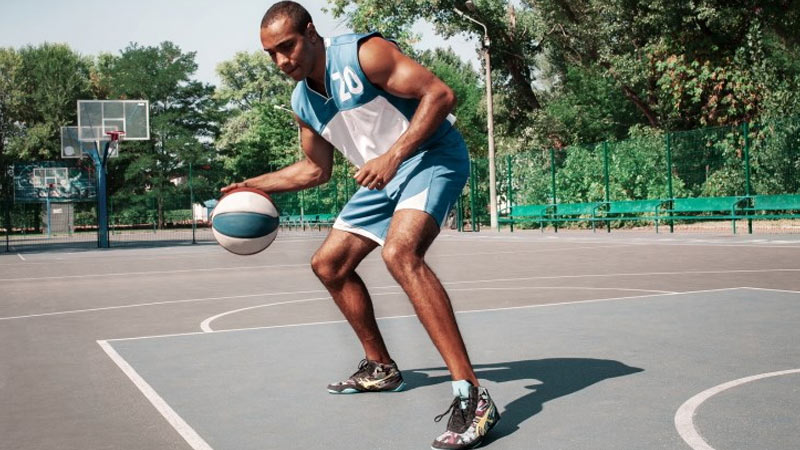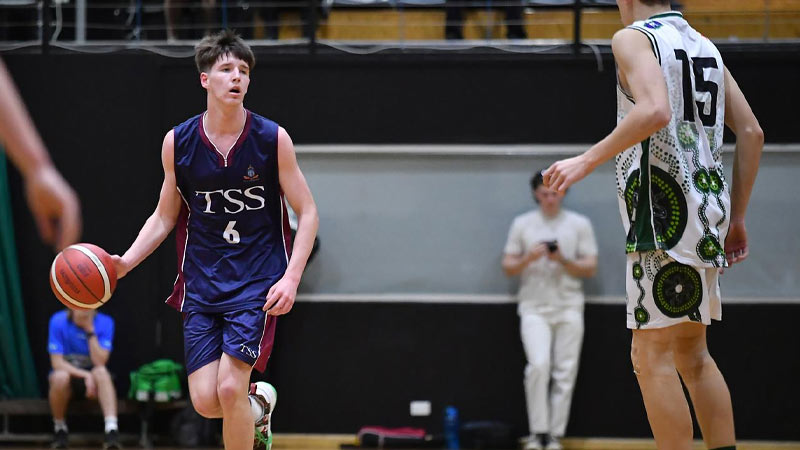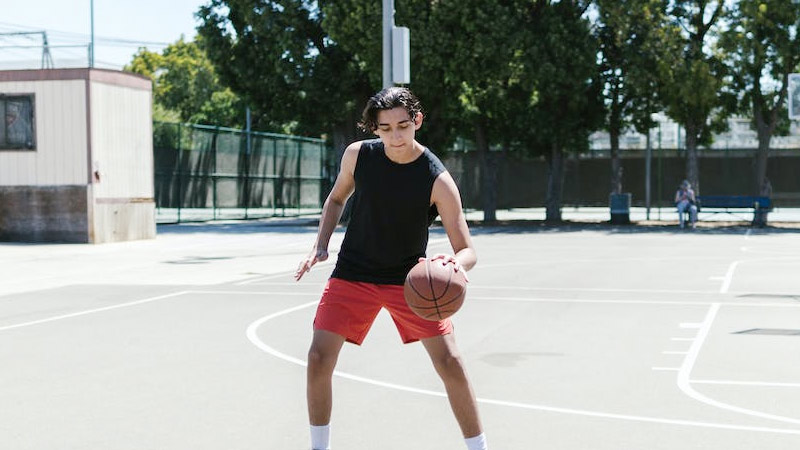Welcome to our comprehensive guide on basketball dribbling tips! Dribbling is one of the fundamental skills in basketball, allowing players to maneuver the ball with finesse and precision while navigating through the defense.
Whether you’re a beginner looking to improve your ball handling or an experienced player aiming to take your dribbling skills to the next level, this blog post is tailored to help you enhance your dribbling techniques.
In this article, we will share valuable insights and practical advice on how to become a more confident and efficient dribbler. From mastering the basics to incorporating advanced moves, we’ve got you covered.
So, let’s dive in and discover the secrets to becoming a standout dribbler on the basketball court!
20 Most Essential Basketball Dribbling Tips
There are tons of basketball dribbling tips that help players to improve their performance. Here are some of the essential dribbling tips.
1. Keep Your Eyes Up
This tip emphasizes the importance of maintaining awareness of the court and your teammates while dribbling. Many beginners tend to stare at the ball while dribbling, which limits their ability to read the game and make quick decisions.
By keeping your eyes up, you can see the entire court, anticipate defensive movements, and find open teammates for better passing opportunities.
2. Use Your Fingertips
Dribbling with your fingertips provides better control over the ball. When you use your palm to dribble, you have less control and are more likely to lose possession.
By using your fingertips, you can have a lighter touch on the ball, making it easier to change direction and handle the ball more precisely.
3. Develop a Strong Off-hand
Your dominant hand is usually more skilled in dribbling, but a strong off-hand can make you a much more versatile player. Practicing dribbling with your non-dominant hand helps improve your overall dribbling ability, allowing you to drive to both sides of the court and evade defenders more effectively.
4. Start Slow
Learning to dribble properly takes time and practice. It’s essential to begin with basic dribbling techniques and gradually progress to more advanced moves. Starting slow allows you to build a strong foundation, perfecting your form and control before attempting complex dribbling maneuvers.
5. Low and Wide Stance
This tip refers to your body positioning while dribbling. Staying low with your knees bent and feet apart lowers your center of gravity, providing better balance and stability.
It also allows you to change direction more quickly and react to defenders more effectively, making it harder for them to steal the ball from you.
6. Practice Stationary Dribbling

Source: sportitude.com
This tip involves working on your dribbling control while standing still. Stationary dribbling drills are designed to enhance your handling skills without the added complexity of movement.
By focusing solely on controlling the ball with your fingertips and wrist movements, you can improve your ball-handling technique and build muscle memory.
This fundamental practice lays the groundwork for more advanced dribbling maneuvers and ensures that you have a solid foundation in ball control.
7. Change of Pace
A crucial aspect of effective ball handling is the ability to change the speed of your dribble. Alternating between fast and slow dribbles makes it challenging for defenders to anticipate your next move.
By using changes of pace, you can catch defenders off guard, create separation, and open up opportunities to drive past them or set up a shot.
Being able to shift gears quickly also allows you to control the tempo of the game, keeping your opponents on their toes and creating advantages for your team.
8. Use Your Body
Basketball is a physical sport, and using your body to protect the ball is an essential skill for any ball-handler. By positioning your body between the ball and the defender, you create a barrier that makes it harder for them to steal the ball from you.
This technique is particularly useful when driving to the basket or trying to protect the ball while waiting for your teammates to get into position. Properly utilizing your body as a shield can help you maintain control and reduce the risk of turnovers.
9. Don’t Telegraph Your Moves

Source: dailytelegraph.com
One of the most common mistakes young players make is telegraphing their intentions. Telegraphing occurs when a player’s body movements or dribbling patterns give away their next move, making it easier for defenders to anticipate and intercept the ball.
To avoid this, you must keep your movements and dribbling unpredictable. Mix up your dribble combinations, use fakes and hesitations, and keep your head up to survey the court.
By mastering the art of deception, you can create opportunities for yourself and your teammates without falling into the trap of predictability.
10. Embrace Both Hands
Many players have a dominant hand that they feel more comfortable dribbling with, but becoming proficient with both hands is a crucial skill for any basketball player. Defenders will try to force you to your weaker hand, so having equal dribbling ability with both hands makes you a more versatile and unpredictable player.
Practice regularly with your non-dominant hand to improve your weak-side dribbling skills. The ability to dribble effectively with both hands not only opens up more opportunities for driving to the hoop but also improves your overall basketball coordination and decision-making.
11. Embrace Both Hands
One of the most crucial aspects of becoming a skilled basketball player is to be proficient with both hands when dribbling. Many players naturally favor their dominant hand, but this can make them predictable and easier to defend. By mastering dribbling with both hands, you become a more versatile and dynamic player.
This allows you to drive to the basket from various angles, protect the ball better from defenders, and execute more creative moves.
To achieve this, practice dribbling drills with your weaker hand regularly, starting with basic stationary dribbling and gradually progressing to more advanced moves.
12. Utilize Crossover Dribbles
The crossover dribble is an essential move that involves quickly changing the ball from one hand to the other while simultaneously changing directions. This move is particularly effective for getting past defenders and creating space for a shot or pass.
To execute a crossover dribble successfully, start by dribbling the ball low and quickly shift it to your opposite hand in front of your body, stepping off the opposite foot.
The key to a successful crossover is to sell the fake convincingly, making the defender believe you’re going in the original direction before abruptly changing course.
13. Add Hesitations
Hesitations are deceptive movements used to confuse defenders. By pausing for a moment during your dribble, you can make the defender hesitate and potentially create a defensive breakdown.
To perform a hesitation move, dribble at a moderate pace, then abruptly stop for a split second before resuming your dribble.
This sudden change of speed can throw off your defender’s timing, allowing you to blow past them or create separation for a shot. Mastering hesitations makes you unpredictable and keeps defenders on their toes.
14. Practice Different Surfaces
Basketball is played on various surfaces, including concrete, hardwood, and grass. Each surface has its unique characteristics, affecting the ball’s bounce and your ability to control it. To become adaptable in different playing environments, regularly practice dribbling on various surfaces.
Dribbling on concrete, for example, requires more control and cushioning, while dribbling on hardwood provides better ball response. By practicing on different surfaces, you develop the ability to adjust your dribbling technique based on the playing conditions, making you a more resilient player.
15. Improve Hand Speed
Hand speed is critical for effective dribbling, especially when facing aggressive defenders. To improve your hand speed, incorporate specific dribbling drills that challenge you to dribble the ball as quickly as possible.
These drills might involve dribbling around cones or defenders, performing speed dribbles up and down the court, or using a weighted ball to enhance your hand speed and ball control.
Developing faster hands enables you to navigate through tight spaces, react quickly to defenders, and execute moves with greater precision.
16. Dribble with a Purpose
Effective dribbling goes beyond aimlessly bouncing the ball; it involves having a clear intention and strategy in mind. Whether you’re looking to score or create opportunities for your teammates, always have a plan while dribbling.
Avoid unnecessary dribbling and make each dribble count towards achieving your objective. This mindset keeps you focused on the game and less likely to commit turnovers. By dribbling with a purpose, you become a more impactful player and gain better control over the flow of the game.
17. Work on Weak Spots
This tip emphasizes the importance of self-assessment in your dribbling skills. Every player has strengths and weaknesses when it comes to dribbling. Identifying these weak spots is crucial for improvement.
It could be difficulty with your non-dominant hand, weak crossover moves, or struggles with advanced dribbling maneuvers. By acknowledging these areas that need improvement, you can tailor your practice sessions to target and strengthen these specific aspects.
Consistent practice and dedication in working on your weak spots will lead to a more well-rounded and confident dribbler on the court.
18. Combine Moves
Basketball is a game of constant motion and improvisation. This tip encourages players to be creative and versatile with their dribbling.
Rather than relying on a single go-to move, the idea is to link various dribbling techniques together seamlessly to create an unpredictable and effective playmaking style.
For example, you can combine a hesitation move with a crossover or between-the-legs dribble to keep defenders guessing and create open scoring opportunities.
y mastering multiple dribbling moves and understanding how to transition between them, you become a more dynamic and challenging player for opponents to defend against.
19. Watch and Learn
Learning from the best is a valuable way to improve your basketball skills. Watching professional players, especially those known for their exceptional dribbling abilities, provides valuable insights into different techniques and strategies.
how they control the ball, react to defenders, and use dribbling to set up plays or create scoring opportunities. Studying their movements and understanding the nuances of their dribbling techniques can inspire you to incorporate new ideas into your own game.
Remember that even though you may not be able to replicate their skills immediately, consistent practice and determination will help you gradually develop and refine your dribbling style.
20. Stay in Control
Dribbling is about maintaining control of the ball while navigating the court and reacting to defenders. It’s essential not to let the ball dictate your movements. This means staying composed, using your fingertips to control the ball, and keeping it low to the ground to minimize turnovers and avoid getting the ball stolen by defenders.
Additionally, maintaining control over the ball allows you to make quick changes in direction or speed, enabling you to maneuver around defenders effectively and create space for your shots or passes. Stay focused on the game, be aware of your surroundings, and avoid making rushed decisions that may lead to turnovers.
FAQs
Why is dribbling essential in basketball?
Dribbling is a fundamental skill in basketball that allows players to maintain possession of the ball while on the move. It enables players to create space, make passes, and drive towards the basket. Without proper dribbling skills, players would be limited in their ability to contribute to the game effectively.
How can I improve my weak hand dribbling?
Improving weak hand dribbling requires dedicated practice. Start with basic stationary dribbling drills using your non-dominant hand and gradually progress to more advanced exercises.
Focus on using your fingertips to control the ball and maintaining a low stance to improve your weak hand coordination and ball-handling abilities.
What are some effective dribbling moves to learn?
Several effective dribbling moves can elevate your game. Among them are the crossover, between-the-legs dribble, behind-the-back dribble, and hesitation move. Mastering these moves will help you become a more versatile and unpredictable dribbler, making it challenging for defenders to guard you.
How can I stay composed and make better decisions while dribbling under pressure?
To stay composed under pressure, focus on keeping your eyes up and being aware of your surroundings. Trust your dribbling skills and practice dribbling under simulated game pressure scenarios.
By incorporating defenders or time constraints into your drills, you can improve your decision-making and handle challenging situations with confidence.
Can watching professional players improve my dribbling skills?
Yes, watching professional players can be immensely beneficial for your dribbling development. Observe how they control the ball, use different moves to get past defenders, and create scoring opportunities.
While you might not be able to replicate their skills immediately, studying their techniques can inspire you to incorporate new ideas into your own game and improve your overall dribbling style.
Wrapping Up
Mastering the art of dribbling is an ongoing journey that requires dedication, practice, and a willingness to learn. By implementing the basketball dribbling tips provided in this blog post, you can enhance your ball-handling skills, become a more versatile player, and elevate your performance on the court.
Remember, consistency is key, so keep honing your dribbling skills and stay committed to improvement. With time and effort, you’ll become a standout dribbler, capable of outmaneuvering opponents and making a significant impact in the game.
So, get out there, hit the court, and let your newfound dribbling prowess shine! Thank you for your time.







